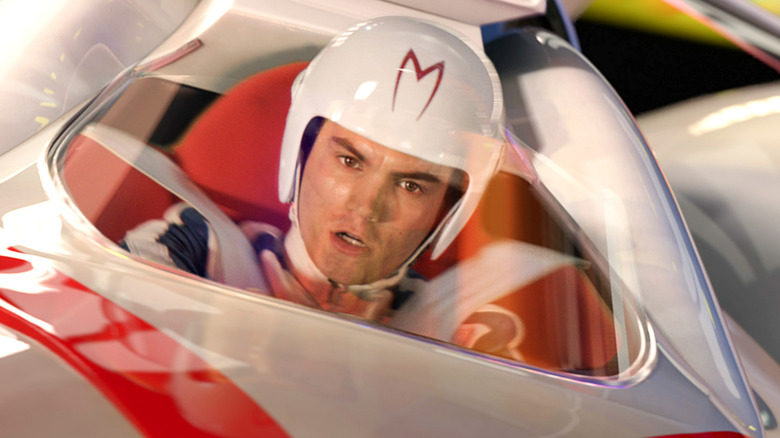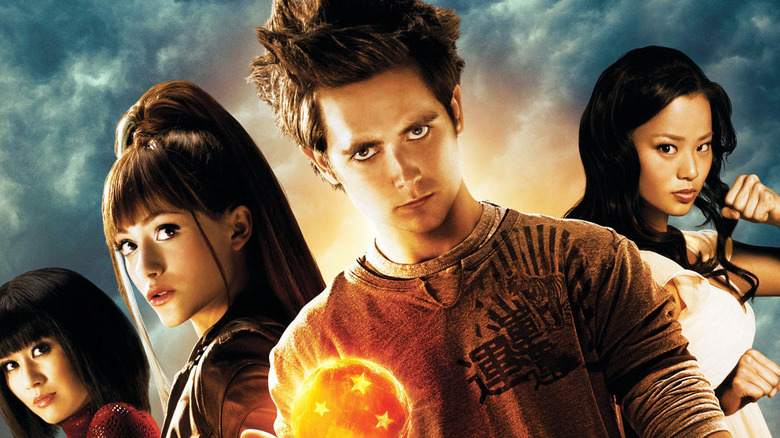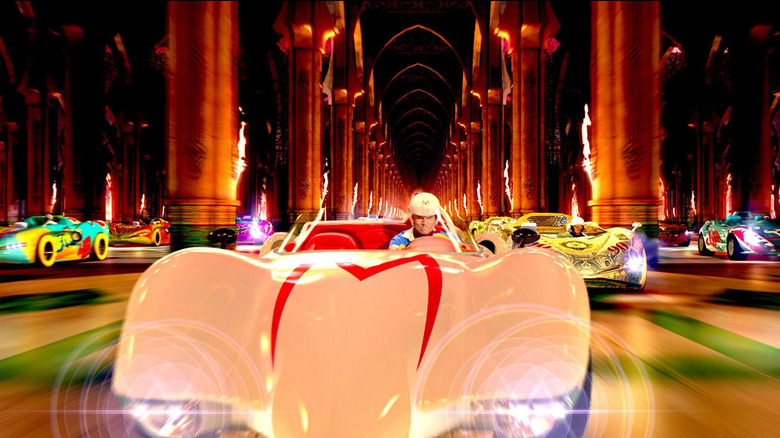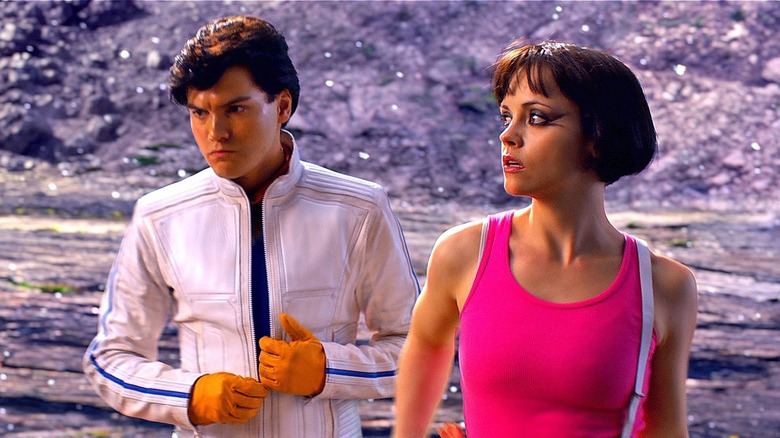Why Speed Racer Is The Best Hollywood Anime Adaptation
In the decades since Japanese animation broke through to the mainstream of Western pop culture, Hollywood has been eager to mine it for precious content. It's not hard to see why. Anime has offered us some of the most fascinating, creatively striking, and challenging entertainment of the past fifty years. Consider the cyberpunk body horror ambitions of "Akira," the space Western melancholy of "Cowboy Bebop," or the astonishing achievements of Studio Ghibli. Anime has exploded in popularity in recent years, in large part thanks to greater accessibility to the material via streaming platforms like Crunchyroll. One such series that has broken through in a major way is "One Piece," a comedy-action saga about warring bands of pirates that is almost as beloved in America as it is in Japan.
Netflix is bringing its live-action English-language adaptation of Eiichiro Oda's work, which is the best-selling manga in history and has its own anime adaptation that runs over literally 1000 episodes and counting. Fans are skeptical that the live-action series will live up to the manic heights of its source material, in large part because Hollywood adaptations of anime have historically been mediocre to terrible. For some reason, American entertainment has never found a consistent way to develop Japanese animation into something that audiences want to see. There is one glorious, retina-burning exception, however, and that is "Speed Racer." Indeed, while the competition is sorely lacking, it remains the most thrilling example of how anime adaptations can be done properly and the unique qualities they could bring to Hollywood storytelling.
Why is anime so tough to adapt?
It doesn't seem as though anime would be so difficult a genre to adapt for American narratives. Many of the most famous series and films are directly influenced by Hollywood, like "Cowboy Bebop," and a lot of these stories are defined by classic plots and characters that transcend language. Yet this side of the ocean has found it a major challenge, to the point where there's a higher ratio of success for video game movies. Like the oft-maligned video game adaptation, anime translations to the big screen are hindered by a distinct lack of appreciation or understanding of the material. It's tough to watch the truly heinous "Dragonball Evolution" and imagine that anyone involved had even seen the original anime, let alone enjoyed it. That film, like many bad anime adaptations, tried to downplay the sheer weirdness and grandeur of its source. All of its originality had been removed and swapped out with a derivative hero's tale that made the entire project feel pointless (they also tried to truncate hundreds of episodes' worth of story into two hours, which is seldom a good idea.) It wasn't alone on this front either.
Many anime adaptations fail because they struggle to Americanize intrinsically Japanese material. The live-action Netflix remake of "Death Note" took a story about a Japanese god of death and the ranks of privilege in the country and made it about a boring white guy who was neither smart nor interesting enough to justify the translation. Others tried too hard to copy the anime scene-for-scene without understanding the aesthetic or tone, as happened with the hugely disappointing Netflix take on "Cowboy Bebop." Whitewashing is also an unavoidable scar on the face of this genre, as stories like "Ghost in the Shell" went out of their way to remove Asian characters and replace them with white actors, thus missing the point of the story and smudging away key cultural context. It seems as though Hollywood's default mode is to sap intriguing and unique properties of everything that made people love them in the first place, all in the name of making them as "universal" (i.e. generic) as possible. This is what makes the adaptation of "Speed Racer" such a miracle. It defied the odds to be truly special.
How the Wachowskis adapted Speed Racer
Also known as "Mach GoGoGo," "Speed Racer" is a manga created by Tatsuo Yoshida. It was originally serialized in print in 1966, then first adapted into an anime the following year. It's one of the earliest examples of anime crossing over to America, as "Speed Racer" in its original iteration aired in syndication there at around the same time as it premiered in Japan. The story follows the Racer family, particularly the eponymous lead, who love race-car driving and compete in the high-stakes world of professional racing. After many adaptations and reboots over the decades, and thanks to its status as a decades-long children's favorite on both sides of the Pacific, a lavish big-budget film felt inevitable. Indeed, Warner Bros. spent well over a decade trying to get one off the ground, with everyone from Henry Rollins to Gus Van Sant to J.J. Abrams attached at one point. It eventually made its way to Lilly and Lana Wachowski, directors of the "Matrix" trilogy. The pair were eager to make a non-R-rated film and "Speed Racer" seemed like a great story to adapt for a family audience. But that didn't mean the directors planned on making anything remotely mainstream.
Lana Wachowski would later say that "Speed Racer" was an excuse for them to make a movie that would "assault every single modern aesthetic." That's no mean feat coming from the pair who made "The Matrix" and would later give the world "Sense8." Their inspirations included cubist artists like Picasso, "Tron," photographer David LaChapelle, James Joyce's "Ulysses," artist Roy Lichtenstein, Hayao Miyazaki's "The Castle of Cagliostro," and Disney's version of "Tarzan." The movie gave the Wachowskis the opportunity to shoot in high-definition for the first time, with the entire production happening on greenscreen sets. They also used a layering approach with their cinematography that would allow both the foreground and the background to be in focus like an anime. According to Lana, Warner Bros. executives reviewed "Speed Racer" while it was still in production and were flabbergasted. "They were like, 'Oh my god. Are you insane? What are you doing? This is the weirdest thing I've ever seen.'" Lana claimed. "And we're like 'Yes, that's the reason we're making it.'" That is certainly reflected in the final product!
Why Speed Racer is great
Story-wise, "Speed Racer" is pretty conventional, and faithful to the core of the anime. It's a classic hero's tale about the power of family, with Emile Hirsch in the lead role, set to the backdrop of racing and the corruption of its governing powers. Narratively, there are some interesting details about corporate overrule and its tainting of the sporting world. But overall, the plot is merely the basic foundation upon which the Wachowskis can tear the screen up with the most striking live-action visualization of the anime aesthetic committed to cinema so far.
"Speed Racer" is essentially an art film with a nine-figure budget, an Andy Warhol painting blended into a classic anime that takes its source material 100% seriously. It's kinetic in a way that many traditional racing films struggle to convey, so full of color and light that watching it becomes strangely hypnotic. It's part cyberpunk, part retrofuturism, part children's fantasy, and it all makes you wish you could immerse yourself fully into such a dreamscape. So, of course, it flopped upon release, grossing only $93.9 million from a $120 million budget. Critics were initially mixed, with many viewing it as too visually exhausting to be a cohesive film, but opinions have mercifully shifted since then.
It's not merely that "Speed Racer" looks exactly like an anime come to life; it also embodies the humor and randomness that most adaptations of the medium rush to dismiss. The performers, including John Goodman, Christina Ricci, and Susan Sarandon, nail the cartoonish tone without descending into parody, and Roger Allam devours the greenscreen scenery as a delectable love-to-hate-them villain (but this is, again, a Hollywood anime adaptation where most of the cast is white.) There's even a chimp! "Speed Racer" so thoroughly embraces the challenge of adapting an anime that it gets rid of realism altogether, and it's the smartest move the Wachowskis could have made.
By the late 2000s, the American blockbuster was moving towards a grittier styling, more Christopher Nolan than Tim Burton, as the evolution of the Batman series around this time showed. The general agenda was one of giving the most fantastical and ludicrous stories a firm grounding in the familiar. It yielded many excellent results, but we started to see far less of the alternative on a similar scale. "Speed Racer" is as far away from real as you can possibly get and the end result is the most loving and earnest version of a live-action anime adaptation one could ask for. It's a real shame that other anime adaptations didn't take this philosophy to heart (imagine if "Dragonball Evolution" had been made in this style.) Despite its commercial underperformance, "Speed Racer" has found a loyal cult following and stands tall as the best in a depressingly unambitious subgenre of adaptations. Let's hope that future American anime re-imaginings learn the right lessons from it.



